支持向量机系列学习笔记包括以下几篇:
Spark机器学习系列之13: 支持向量机SVM :http://blog.csdn.net/qq_34531825/article/details/52881804
支持向量机学习之2:核函数http://blog.csdn.net/qq_34531825/article/details/52895621
支持向量机学习之3:SVR(回归)http://blog.csdn.net/qq_34531825/article/details/52891780
ϵ−SVR
SVR回归中,基本思路和SVM中是一样的,在
ϵ−SVR
[Vapnic,1995] 需要解决如下的优化问题。
细心的读者可能已经发现了与 C−SVM 中的具有相似的地方,但又不太一样,那么如何理解上述公式呢?
假设我们的训练数据集是 {(x1,y1),(x2,y2),...(xn,yl)}
我们的目标是找到一个函数,比如线性函数 f(x)=wTx+b ,使得
如果数据离回归函数的偏差 |yi−wTx−b|<ϵ| (下图非色区域),我们是能接受的,不需要付出任何代价(即不需要在代价函数中体现)。我们只关注偏差大于 ϵ 的代价。举个例子来说,就好比我们在换外币时,我们并不关注少量 ϵ 损失,这部分损失是汇率引起的合理损失。
所以约束条件是保证更多多的数据点都在灰色范围内(拟合最佳的线性回归函数,使得更多的点落在我们接受的精度范围内),即 |yi−wTx−b|<ϵ| 。但是我们发现,还是会有一部分点,偏差比较大,落在灰色区域之外,所以类似SVM中使用的方法,引入松弛因子,采取软边界的方法,而且上下采取不同的松弛因子 ξi,ξ∗i≥0 ,这样就不难得出约束条件为:
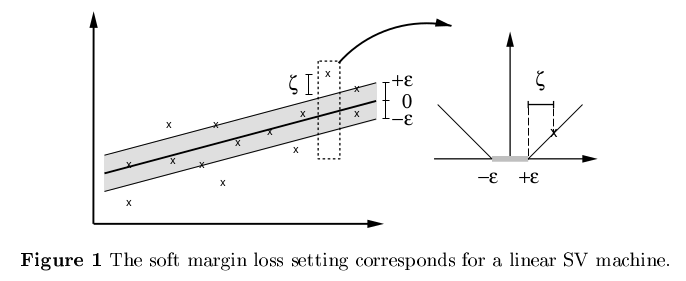
如同SVM中一样的,在多数情况下转换为对偶问题更容易计算。同时还可以计算出 w 和

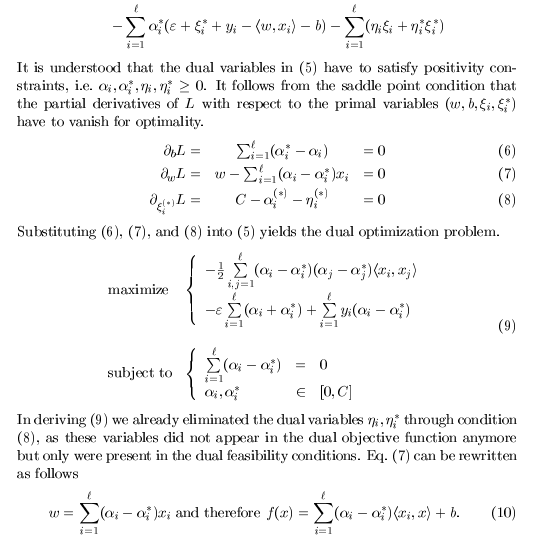

详细推导过程看文献1。
使用核函数的 ϵ−SVR
文献2
ν−SVR
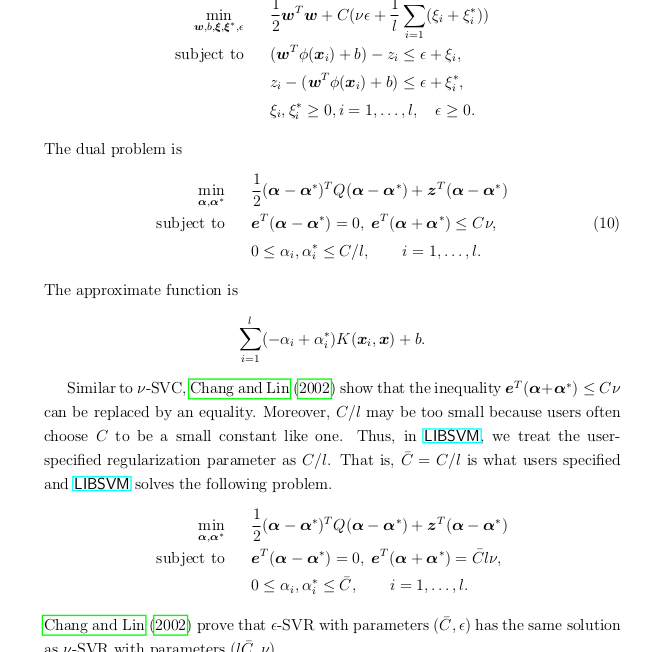
Chang and Lin (2002) prove that
ϵ
-SVR with parameters
(C¯¯¯̄ ,ϵ)
has the same solution as
ν
-SVR with parameters
(lC¯¯¯̄ ,ν)
.
其实两种SVR在满足一定条件下,具有相同的解。
优缺点分析
Scikit代码
#-*-coding:utf-8-*-
import numpy as np
from sklearn.svm import SVR
import matplotlib.pyplot as plt
###############################################################################
# Generate sample data
X = np.sort(5 * np.random.rand(40, 1), axis=0) #产生40组数据,每组一个数据,axis=0决定按列排列,=1表示行排列
y = np.sin(X).ravel() #np.sin()输出的是列,和X对应,ravel表示转换成行
###############################################################################
# Add noise to targets
y[::5] += 3 * (0.5 - np.random.rand(8))
###############################################################################
# Fit regression model
svr_rbf10 = SVR(kernel='rbf',C=100, gamma=10.0)
svr_rbf1 = SVR(kernel='rbf', C=100, gamma=0.1)
svr_rbf1 = SVR(kernel='rbf', C=100, gamma=0.1)
#svr_lin = SVR(kernel='linear', C=1e3)
#svr_poly = SVR(kernel='poly', C=1e3, degree=3)
y_rbf10 = svr_rbf10.fit(X, y).predict(X)
y_rbf1 = svr_rbf1.fit(X, y).predict(X)
#y_lin = svr_lin.fit(X, y).predict(X)
#y_poly = svr_poly.fit(X, y).predict(X)
###############################################################################
# look at the results
lw = 2 #line width
plt.scatter(X, y, color='darkorange', label='data')
plt.hold('on')
plt.plot(X, y_rbf10, color='navy', lw=lw, label='RBF gamma=10.0')
plt.plot(X, y_rbf1, color='c', lw=lw, label='RBF gamma=1.0')
#plt.plot(X, y_lin, color='c', lw=lw, label='Linear model')
#plt.plot(X, y_poly, color='cornflowerblue', lw=lw, label='Polynomial model')
plt.xlabel('data')
plt.ylabel('target')
plt.title('Support Vector Regression')
plt.legend()
plt.show()RBF不同参数:
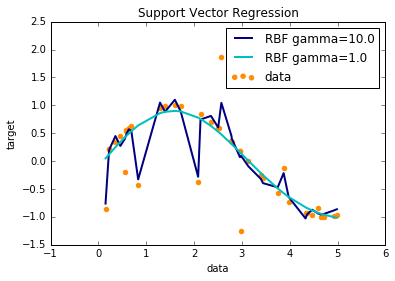
不同核函数:
主要参考文献
(1)A Tutorial on Support Vector Regression ,Alex J
http://www.svms.org/regression/SmSc98.pdf
(2)LIBSVM:A library for Support Vector-Machines Chih-Chung Chang and Chih-Jen Lin
(3)支持向量机回归算法研究 硕士学位论文










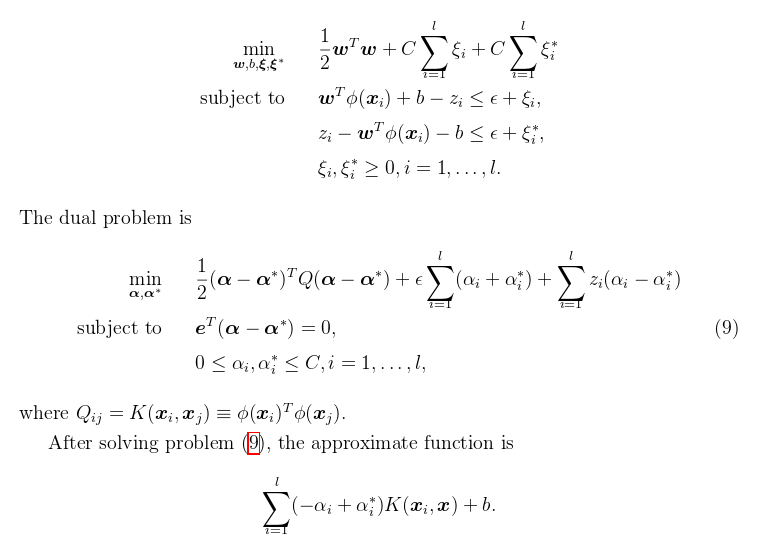
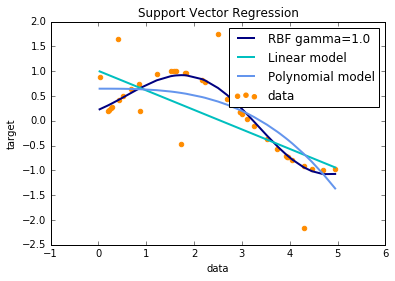














 3083
3083

 被折叠的 条评论
为什么被折叠?
被折叠的 条评论
为什么被折叠?








